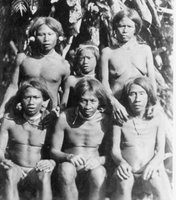 "The Shompen are the "other Nicobaris", an enigmatic tribe living in the densely forested interior of Great Nicobar. There number has been roughly estimated at 300 in 2001. Very little is known about them. Recent unpublished genetic studies have indicated that the Shompen have different origins from the "ordinary" Nicobaris, although both groups have Mongolid ancestry. The ancestral Shompen came to Great Nicobar from Sumatra, more (maybe much more) than 10,000 years ago. The Nicobaris, on the other hand, came from the east, from mainland southeast Asia many thousands of years later. There is some genetic and linguistic evidence that the two groups mixed to a limited extent. Earlier suspected links to Negrito populations, however, have not been found. A peculiarity of the Shompen discovered in 1967 was that all of 55 individuals then screened turned out to have blood group O in the ABO system."
"The Shompen are the "other Nicobaris", an enigmatic tribe living in the densely forested interior of Great Nicobar. There number has been roughly estimated at 300 in 2001. Very little is known about them. Recent unpublished genetic studies have indicated that the Shompen have different origins from the "ordinary" Nicobaris, although both groups have Mongolid ancestry. The ancestral Shompen came to Great Nicobar from Sumatra, more (maybe much more) than 10,000 years ago. The Nicobaris, on the other hand, came from the east, from mainland southeast Asia many thousands of years later. There is some genetic and linguistic evidence that the two groups mixed to a limited extent. Earlier suspected links to Negrito populations, however, have not been found. A peculiarity of the Shompen discovered in 1967 was that all of 55 individuals then screened turned out to have blood group O in the ABO system."J Hum Genet. 2006;51(3):217-26. Epub 2006 Feb 2.
Molecular insights into the origins of the Shompen, a declining population of the Nicobar archipelago.
Trivedi R, Sitalaximi T, Banerjee J, Singh A, Sircar PK, Kashyap VK.
The Shompen, one of the most isolated and poorly understood contemporary hunter-gatherer populations, inhabit Great Nicobar Island, the southernmost island of the Nicobar archipelago. Morphological imprints in the Shompen were interpreted to favour a mixed Indo-Chinese, Malay, Negrito and Dravidian origin. Analyses of the mitochondrial, Y-chromosomal and autosomal gene pool of contemporary Shompen have revealed low diversity, illustrating a founder effect in the island population. Mitochondrial sequence analyses revealed the presence of two haplogroups of R lineage: B5a, and a newly defined clade, R12. Y-chromosomal analyses demonstrated the occurrence of a single lineage found predominantly in Austro-Asiatic speakers across Asia. With the different types of genetic markers analysed, the Shompen exhibit varying levels of genetic relatedness with the Nicobarese, and Austro-Asiatic speakers of mainland India and Southeast Asia. These genetic analyses provide evidence that the Shompen, an offshoot of the Nicobarese, are descendants of Mesolithic hunter-gatherers of Southeast Asian origin, deriving from at least two source populations.
Link

No comments:
Post a Comment